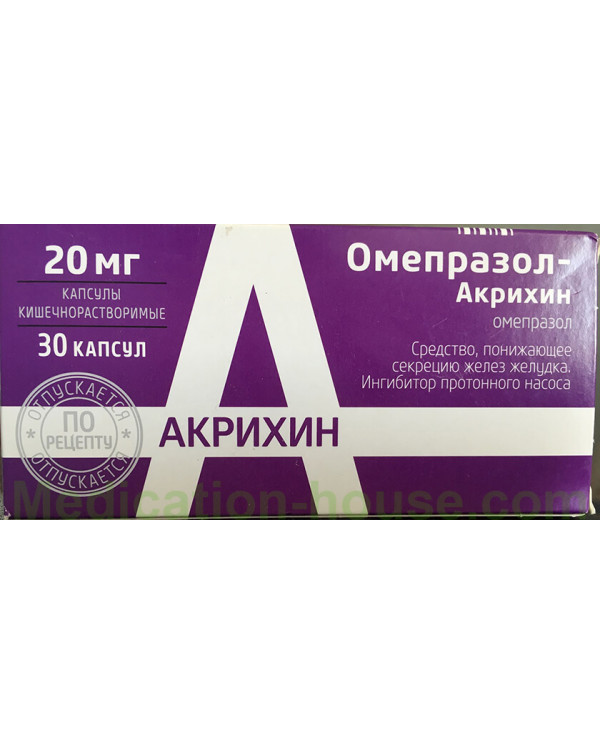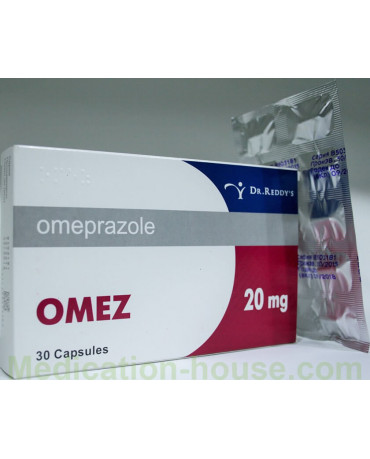Instruction for Omeprazole
Omeprazole is one of the most modern antisecretory drugs used in the treatment of peptic ulcer and erosive inflammatory diseases of the upper gastrointestinal tract. According to the mechanism of action, it relates to proton pump inhibitors.
Omeprazole inhibits the production of hydrochloric acid in the stomach and reduces its activity. This drug acquires its healing properties only after getting into an acidic environment, which is just characteristic of the stomach.
After oral administration, the drug actively penetrates into the special cells of the stomach that are responsible for the secretion of hydrochloric acid. In them, it accumulates and, thus, regulates the production of gastric juice and pepsin (an enzyme that breaks down proteins).
Omeprazole has a bactericidal effect on the main "culprit" of gastritis and peptic ulcer - the microorganism Helicobacter pylori (Helicobacter pylori). That is why Omeprazole is mandatory in the list of drugs that suppress Helicobacter pylori infection with gastric ulcer and duodenal ulcer.
With pathological reflux of gastric contents into the esophagus (reflux ulcerative and erosive esophagitis), the mucous membrane is inevitably damaged and ulcerative defects form on it. Omeprazole taken orally can reduce the damaging effect of hydrochloric acid, restore the pH of gastric juice and significantly reduce the severity of the main symptoms of the disease.
Omeprazole not only significantly improves the well-being of patients, but also leads to a sharp decrease in the likelihood of a return of the disease and the development of its complications. Its action begins 1 hour after ingestion and lasts for a day. Omeprazole reaches a therapeutic maximum after 2 hours. The higher the dose of the drug, the stronger the inhibitory effect on the parietal (producing hydrochloric acid) cells of the stomach.
Omeprazole is excreted from the body through the kidneys (up to 80%) and the intestines (about 20%). In the elderly, as well as in chronic renal failure, elimination of the drug from the body can be slowed down.
Release Forms
In the pharmacy chain, Omeprazole is sold in tablets, capsules and solutions for intravenous administration.
1. Enteric capsules contain 10 mg or 20 mg of the main active ingredient - omeprazole (7 capsules in a blister pack, in a pack there can be from 1 to 4 blister plates); some manufacturers pack 30 or 40 capsules in polymer cans;
2. MAPS tablets (pellets), coated with 10 mg, 20 mg or 40 mg of the active substance (No. 7, 14, 28);
3. Powder for infusion solutions in 40 mg vials (5 vials per pack).
Indications for use
Omeprazole has wide indications for diseases of the upper gastrointestinal tract. The drug is usually prescribed for adults and children over 5 years of age in the following cases:
1. In the complex treatment of the active phase of gastric ulcer and duodenal ulcer associated with Helicobacter pylori infection;
2. For the treatment of Zollinger-Ellison syndrome;
3. For stopping manifestations of gastroesophageal reflux (reflux of gastric contents into the lower part of the esophagus);
4. To eliminate uncomplicated heartburn, which lasts more than 2 days during the week;
5. As a course of treatment for endoscopically confirmed erosive esophagitis;
6. For the correction of hypersecretory disorders in the upper part of the digestive tract;
7. For the treatment of gastropathy, which were formed from taking non-steroidal anti-inflammatory drugs;
8. In the combined treatment of polyendocrine adenomatosis;
9. Preventively, to prevent relapse in chronic duodenal ulcer, aspirin and stress ulcer.
Contraindications
The main contraindication for taking the drug is intolerance to any of the components of the drug.
In addition, the drug is not recommended to be taken during pregnancy. It has been clinically proven that taking the drug, especially in the first trimester of pregnancy, can lead to fetal malformations. Therefore, the drug is prescribed only in extreme cases, when the benefits of its use significantly exceed the side effects.
The drug penetrates well and quickly into the blood and breast milk, so it is not prescribed during lactation.
Omeprazole helps to reduce the acidity of gastric juice, in this regard, it is not prescribed for gastritis with low acidity, atrophic gastritis.
Omeprazole is also contraindicated in patients with suspected cancer of the stomach or duodenum. In this case, the drug can level the existing symptoms and complicate the final diagnosis. There is evidence that omeprazole with this pathology can stimulate the growth of an existing tumor.
Among other contraindications, osteoporosis and a tendency to spontaneous bone fractures should be noted. Omeprazole leaches calcium from bones, so it can enhance the effects of osteoporosis. In case of emergency, treatment with omeprazole is allowed under the guise of calcium and vitamin D.
Before prescribing the drug, you need to make sure that the patient does not have the following conditions:
Malignant tumors of the digestive tract;
Gastrointestinal infections - salmonella, compilobacter, because Omeprazole may enhance their reproduction;
Hepatic insufficiency - in this case, the biotransformation of the drug sharply slows down and toxic inflammation of the liver cells occurs;
Renal failure slows the elimination of the drug from the body.
Side effects
Side effects from taking omeprazole are quite rare. As a rule, they occur with improper or prolonged use of the drug (more than 2-3 months in a row). In these cases, digestive disorders are most commonly observed - nausea, bloating and abdominal pain, diarrhea or constipation. Some patients complain of headaches and dizziness. All symptoms usually disappear on their own after discontinuation of the drug.
In addition, the drug may cause:
Violation of taste, dryness and inflammation of the oral mucosa.
Nausea, vomiting, unstable stools, flatulence.
Impaired liver function.
Disorders from the nervous system (in patients with severe concomitant diseases) - depression, increased irritability, headache, lethargy, weakness, sometimes encephalopathy.
Skin rashes, itching, redness and peeling, exudative erythema, increased sensitivity to light, local baldness.
Allergic reactions in the form of fever, urticaria, Quincke's edema, spasm of the muscles of the bronchi, interstitial nephritis; in very rare cases, anaphylactic shock.
Changes in the qualitative and quantitative composition of the blood - a decrease in the number of leukocytes, platelets; B12 folic acid deficiency anemia sometimes develops.
Sometimes pain in large joints and muscles is observed, and muscle weakness also develops.
Extremely rare side effects are an increase and engorgement of the mammary glands, a decrease in visual acuity, swelling on the lower extremities, the formation of glandular cysts in the stomach that are benign and reversible.
Treatment
Due to the fact that improper or uncontrolled administration of the drug can cause serious harm to the gastrointestinal tract, only a doctor can prescribe it.
How to take?
Omeprazole should be taken immediately before meals or during breakfast. If you need to take the drug again during the day, it is usually prescribed for the evening.
Capsules cannot be chewed or divided into parts. The desired dose of the drug is washed down with a small amount of pure still water.
If Omeprazole tablets (pellets) are used as a therapeutic agent, they are allowed to be dissolved in acidified water, yogurt or juice (15-20 ml). The diluted drug should be drunk within 30 minutes.
Dosage
The standard single dose of the drug is 20 mg, but it can be adjusted by the doctor depending on the severity of the disease and the general condition of the patient. Omeprazole is prescribed in courses of no more than 2 months, after which a break for several months is necessary.
With gastric ulcer in the acute stage, Omeprazole is prescribed at 20-40 mg per day, the dose is divided into 2 doses. The course of treatment is from 1 to 2 months.
With erosive and ulcerative esophagitis, treatment is prescribed similarly to gastric ulcer. As an anti-relapse treatment, 20 mg of omeprazole per day is prescribed. The duration of treatment can be from 1 to 2 months.
For duodenal ulcers, the daily dose of the drug is 20 mg, the course of treatment is 2-4 weeks. For the prevention of relapse of the disease, maintenance doses of omeprazole are prescribed for up to 4 weeks. In this case, it is necessary to use capsules containing 10 mg of the main active substance.
With gastropathy and erosive-ulcerative lesions caused by taking non-steroidal anti-inflammatory drugs, 1 capsule of Omeprazole is prescribed per day for a period of 4 to 8 weeks.
For the treatment of Zollinger-Ellison syndrome, the dose of Omeprazole is selected strictly individually, depending on the initial level of secretory activity of the stomach. The minimum daily dose is 60 mg. In the future, the dose may increase to 120 mg / day, while the amount of the drug is divided into 2 doses - in the morning and evening.
For the treatment of Helicobacter pylori infection take 20 mg of the drug in the morning and evening, the minimum course is 7 days. Omeprazole with this treatment is always taken in a single unit with antibacterial agents, according to one of the existing schemes (triple or quadrotherapy).
For relief of uncomplicated heartburn, 20 mg of omeprazole is prescribed once a day for 14 days. A second course of treatment is possible after 4 months.
In patients with concomitant liver diseases, the daily dose should not exceed 20 mg.
To prevent leakage of acidic gastric contents into the esophagus during prolonged operations, Omeprazole is prescribed at 40 mg the day before and 2-4 hours before surgery.
If the patient is in a serious condition, especially if he is in the intensive care unit, Omeprazole can be administered directly through the catheter into the stomach, or sterile solutions for intravenous infusion can be used. For introduction through a catheter, it is necessary to dilute 20 mg of the powder from the capsule in 30 ml of water, insist for 3-5 minutes and enter through a gastric tube. For intravenous drip, 40 mg of sterile Omeprazole powder (1 bottle) is diluted in 100 ml of 0.9% sodium chloride solution or in 5% glucose.
For children
For children under 5 years of age, the drug is usually not prescribed. However, with Zollinger-Ellison syndrome and some other acute diseases of the upper digestive tract, the doctor may prescribe Omeprazole. In this case, the dose of the drug is calculated based on the body weight of the child.
1. With a body weight of up to 10 kg, the drug is prescribed 5 mg per day.
2. With a weight of 10 to 20 kg, the daily dose of the drug is 10 mg.
3. With a child’s body weight of 20 kg or more, a single dose of 20 mg of Omeprazole per day is allowed.
During pregnancy
Pregnancy is a contraindication for the appointment of omeprazole. It is especially important to avoid taking the drug in the first trimester of pregnancy, because in this case, the risk of developing pathology of the cardiovascular system in the fetus increases sharply. In the remaining stages of pregnancy, Omeprazole is prescribed with great caution and only if the positive effects of the drug outweigh the possible side effects.
For gastritis
Omeprazole is prescribed only for gastritis with high acidity! With normo-and hypoacid gastritis, the drug is contraindicated and can provoke the development of atrophic gastritis with zero acidity of gastric juice.
The maximum effect of a single dose of Omeprazole in a dose of 20 mg occurs on average after 1.5-2 hours. The therapeutic effect of the drug lasts from 18 to 24 hours, therefore, with gastritis, the daily dose of Omeprazole is 1 capsule (20 mg). The duration of treatment usually does not exceed 2-3 weeks. During this time, the acidity of the stomach normalizes and the main symptoms of gastritis are eliminated.
If gastritis is associated with Helicobacter pylori infection, then, along with Omeprazole, it is necessary to carry out mandatory antibacterial treatment according to one of the schemes generally accepted in this case (triple therapy).
For Heartburn
Omeprazole effectively eliminates the effects of heartburn in various diseases of the gastrointestinal tract. However, its independent reception is allowed only as an exception, as an ambulance. Its dose in this case should not exceed 10 mg per day. The therapeutic effect of Omeprazole develops after 4-5 days, and the full course of treatment should not exceed 14 days. Omeprazole treatment can be repeated no earlier than 4 months later.
If heartburn returns at the end of treatment, you should consult a doctor for advice and examination. The same should be done with frequently recurring heartburn, especially if they occur more than 2 days a week. In this case, appropriate treatment with Omeprazole in appropriate dosages will be prescribed.
Interactions with Other Medicines
Omeprazole can change the effect of any drug (ketoconazole, Itraconazole, Ampicillin, iron salts, etc.), the activity and absorption of which depends on the pH of the stomach.
Drugs that are transformed in the liver (Warfarin, Diazepam, Phenytoin, etc.) can, when interacting with the drug, break down more slowly, increasing their concentration in the blood and tissues. Omeprazole also slows the release of tranquilizers from the body (Sibazon, Diazepam, Elenium). In these cases, a dose reduction of these drugs may be required.
Omeprazole may enhance the effect of indirect anticoagulants and anticonvulsants (coumarins, diphenin). With the simultaneous administration of Clarithromycin and Omeprazole, a mutual enhancement of effects occurs.
Omeprazole enhances the negative effect on the hematopoietic system of other drugs.
Terms of sell
You don't need a prescription to buy Omeprazole.






